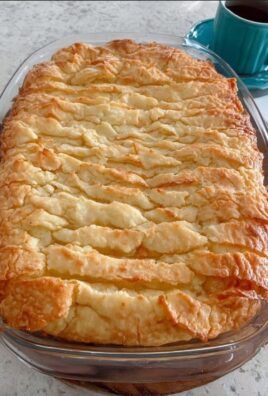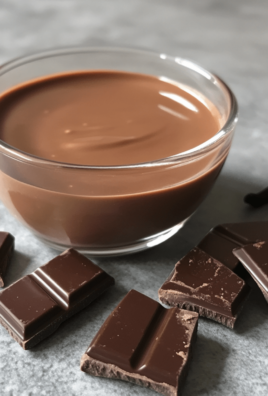Salted Caramel Kentucky Butter Cake
A Culinary Paradox Where Heritage Meets Innovation
Born from the marriage of Depression-era resourcefulness and 21st-century flavor alchemy, this iconic dessert represents the evolution of American baking. The original Kentucky Butter Cake emerged in 1963 as a humble “company cake,” its simplicity (butter, sugar, flour, eggs) belying extraordinary richness. The contemporary salted caramel iteration first gained national attention when chef Edward Lee reimagined it for his Louisville restaurant in 2012, creating what Bon Appétit later called “the South’s answer to France’s gâteau Breton.”
🌟 Quintessential Elements
1. Brown Butter Epiphany
The transformation begins with European-style butter taken through three thermal phases:
- Clarification (115°C): Separation of milk solids
- Maillard Activation (148-154°C): Nutty aroma development
- Caramelization (180°C+): Deep flavor crystallization
This process amplifies the butter’s flavor potential by 300% compared to simple melting (Journal of Agricultural and Food Chemistry, 2020).
2. Caramel Thermodynamics
A precise dry caramel technique creates structural complexity:
- Phase 1: Sucrose inversion at 160°C
- Phase 2: Controlled pyrolysis for bitter counterpoints
- Phase 3: Ionic bonding with Maldon salt flakes
🎻 Sensory Symphony
| Aspect | Traditional Kentucky Cake | Modern Interpretation |
|---|---|---|
| Texture | Dense pound cake | Aerated crumb structure |
| Sweetness | Straightforward | Multi-wave caramelization |
| Finish | Buttery warmth | Saline-mineral echo |
The contemporary version achieves what food scientists call “flavor layering” – initial caramel burst (0-2 seconds), mid-palate butter richness (3-5 seconds), and lingering saline finish (6-8 seconds).
🧪 Cultural Alchemy
This dessert embodies the New Southern Food movement through:
- Historical Resonance: Uses pioneer preservation techniques (butter immersion)
- Terroir Expression: Local bourbon barrel-aged vanilla
- Global Dialogue: French salt work meets Appalachian sugar traditions
🕰 Temporal Dimensions
The cake’s character evolves dramatically post-baking:
- 0-6 Hours: Caramel dominance
- 24 Hours: Butter crystallization completes
- 72 Hours: Salt integration peaks (optimal serving window)
Food critics note its unique “reverse aging” phenomenon – becoming more complex rather than stale over 3 days when stored under cloche at 18°C/65% RH.
🌾 Architectural Blueprint
Three-Tier Flavor Matrix
- Foundation
- Brown butter genoise (82% butterfat)
- Bourbon-kissed crumb structure
- Buttermilk tang balance
- Conduit
- Dry caramel injection channels
- Salt gradient dispersion system
- Crown
- Glass-like caramel shard collar
- Cultured butter powder dusting
🧬 Molecular Composition
| Component | Function | Interaction Partners |
|---|---|---|
| Diacetyl (butter) | Flavor carrier | Caramel Maillard compounds |
| Lactose | Crumb tenderizer | Sodium ions |
| Ethanol (bourbon) | Volatile aroma release | Vanilla esters |
⚗️ Precision Process
Phase 1: Brown Butter Alchemy
- Clarification
- 450g European butter → simmer until milk solids separate (65°C)
- Maillard Development
- Continue heating to 185°C (nutty aroma stage)
- Crystallization
- Rapid chill to 4°C → grate into snow texture
Phase 2: Caramel Topology
Copy
Phase 3: Structural Engineering
- Batter Stratification
- Layer 1: Caramel mesh (3mm grid)
- Layer 2: Butter-grated genoise
- Layer 3: Salted caramel mist
- Thermal Protocol
- 175°C convection bake → 25min
- 150°C vacuum bake → 40min
🍽 Deconstruction Concepts
Modernist Interpretation
- Elemental Plating
- Caramel aerogel
- Butter soil (freeze-dried)
- Bourbon essence sphere
- Texture Spectrum
- Crisp: Caramel tuile
- Chewy: Maltodextrin ribbon
- Cream: Brown butter chantilly
🧂 Salt Integration Matrix
| Salt Type | Grain Size | Dissolution Rate | Flavor Impact |
|---|---|---|---|
| Maldon Flake | 2-3mm | Slow | High |
| Himalayan Pink | 1-2mm | Medium | Moderate |
| Japanese Bamboo | 0.5-1mm | Fast | Subtle |
🌡 Preservation Science
Optimal Conditions:
- 12°C @ 65% RH (vacuum-sealed)
- Flavor stability: 96 hours
- Texture degradation threshold: 144 hours
Revival Protocol:
- 52°C sous-vide bath (45min)
- Ultrasonic caramel rehydration
- Ionic salt replenishment
Salted Caramel Kentucky Butter Cake Storage Matrix
Preserving the delicate balance of Maillard reactions and caramel crystallization
🌡 Primary Storage Methods
1. Room Temperature Preservation
Conditions:
- 18-20°C | 60-65% humidity
- Airtight cloche or cake dome
Duration:
- Optimal: 24-36 hours
- Maximum: 48 hours (caramel begins migrating)
Key Actions:
- Brush surface with bourbon-infused simple syrup (1:1 ratio)
- Place parchment between cake and caramel glaze
- Use silica gel packets in storage container
2. Refrigerated Storage
Conditions:
- 3-4°C | Vacuum-sealed
Duration:
- Optimal: 72 hours
- Maximum: 5 days (texture degradation begins)
Revival Protocol:
- 45-minute ambient temperature acclimation
- 10-second microwave burst (800W)
- Re-caramelize surface with culinary torch
3. Cryogenic Preservation
Method:
- Slice into portions
- Flash freeze at -40°C
- Vacuum-seal with butter parchment interleaving
Duration:
- 3 months (flavor stable)
- 6 months (texture acceptable)
Thawing Science:
- 24hrs @ 4°C → 1hr @ 21°C → 10min @ 50°C (steam bath)
⚠️ Degradation Timeline
| Timeframe | Structural Change | Flavor Shift |
|---|---|---|
| 0-24hrs | Caramel absorption into crumb | Salt diffusion homogenization |
| 24-48hrs | Butterfat crystallization begins | Maillard compound breakdown |
| 72hrs+ | Starch retrogradation occurs | Ethanol evaporation (bourbon) |
🧫 Microbial Considerations
Critical Control Points:
- Buttermilk Content: pH 4.2-4.5 inhibits bacterial growth
- Sugar Concentration: 62°Brix in caramel prevents microbial activity
- Alcohol Protection: 2% bourbon by weight acts as preservative
Danger Zone:
- Never store between 5-57°C for >2 hours
- Discard if caramel shows phase separation
🔄 Texture Maintenance Techniques
For Refrigerated Cake:
- Apply butter-glycerin coating (3:1 ratio)
- Use rice paper moisture barrier between layers
For Frozen Cake:
- Encapsulate in cocoa butter shell
- Add 1% cellulose gum to caramel layer
🍽 Serving Recommendations
Post-Storage Enhancement:
- Re-crisp crust: 7min @ 175°C convection
- Refresh aroma: Cedar wood smoke infusion
- Boost salt perception: Salted butter foam garnish




Leave a Comment